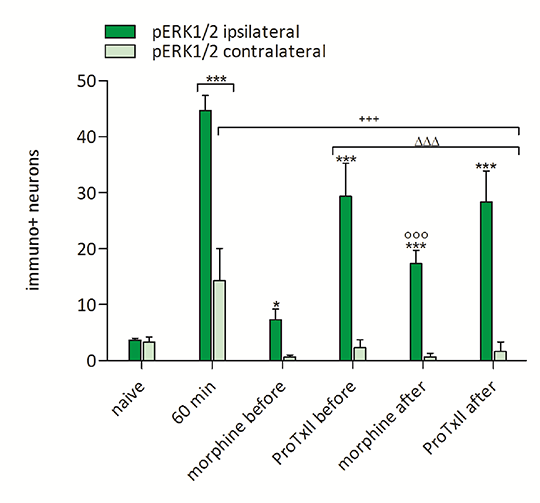Blocking Nav1.7 Reduces Spinal pERK1/2 Expression Evoked by Severe Burn Injury Introduction: controlling pain in burn injury patients, which is one of the most excruciating pain sensations that can be experienced, is still a major clinical challenge and an unmet medical need (1). There is evidence that the sodium channel expressing the α subunit Nav1.7 (Nav1.7) has an important role in nociceptive processing. Nav1.7 has recently been implicated in the development of burn-induced hypersensitivity. Thus, Nav1.7 is a potential therapeutic target for controlling pain after burn injury . Our aim was to find out whether blocking Nav1.7 channels (2) is able to reduce nociceptive processing in the spinal cord. Methods: experiments were performed in accordance with the requirements of the Animals (Scientific Procedures) Act 1986 (UK) Amendment Regulations 2012 (SI 2012/3039) and adhered to the guidelines of the Committee for Research and Ethical Issues of IASP published in Pain, 16 (1983) 109- 110. One of the hind paws of urethane-anaesthetised Sprague-Dawley adult male rats was immersed into 60oC water for 2 minutes to induce a partial thickness second degree scalding type burn injury (3). The Nav1.7 blocker, ProTx-II, was injected (0.1 mg/Kg; i.p.) 15 minutes before or after the burn injury. Morphine (3 mg/Kg; i.p.) was use as positive control. Following various survival times up to 3 hours, rats were perfused with 4% paraformaldehyde and the L4-5 spinal cord and DRG were collected and processed for immunostaining using an anti-pERK1/2 (phosphorylated extracellular-signal-regulated kinases 1 and 2) antibody, a recognised marker for spinal nociceptive processing.
Immunollabeled pERK1/2 neurons in the Conclusion: blocking Nav1.7 could be a new means to reduce pain in burn injured patients. (1) Laycock H et al. (2013). Eur J Pain 716: 169-178. (2) Schmalhofer WA et al. (2008). Mol Pharmacol 74: 1476-1484. (3) White JP et al. (2011). Eur J Pain 15: 683-690White JP et al. (2011). European Journal of Pharmacology 15: 683-690
|


